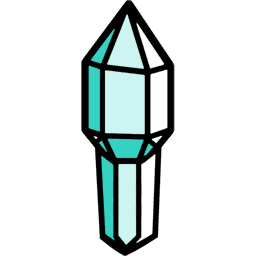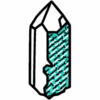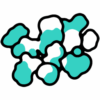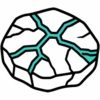Scepters – Crystals of Power and Renewal
 Crystals of Power and Renewal
Crystals of Power and Renewal
Some crystals grow like royalty. Their slender stems rise gracefully before blooming into magnificent heads, as if crowned by the Earth herself. These are Scepter Crystals – nature’s own symbols of authority and transformation.
But what gives these crystals their regal form? Why do some grow into shapes that look like ceremonial wands or staffs, while others remain simple and unadorned?
The answer lies in a rare geological event – a pause, a shift, and then a powerful resurgence.
Scepters are formed when a second generation of crystal growth occurs atop an older one, creating a distinct “head” that rests upon a thinner “stem.” This isn’t just a matter of aesthetic luck; it’s a geological narrative of change and resilience. The first growth halts, perhaps due to cooling temperatures or changes in mineral-rich waters. Later, conditions stabilize or shift again, allowing a new layer to crystallize over the original tip – but differently this time. The result is a formation that looks both ancient and reborn.
How Scepters Take Shape
Every scepter begins humbly – as a single crystal growing deep within the Earth’s hydrothermal veins. The process seems straightforward at first: minerals dissolve into superheated water and begin to crystallize slowly over time. But nature loves a twist.
At some point, the conditions that nurtured that first crystal shift. The mineral-laden fluid cools, pressure changes, or chemical composition alters just enough to halt the crystal’s steady growth. For a time, everything stops.
Then, a new wave of geological activity begins. Temperature rises again. The chemistry of the fluid changes once more. Suddenly, the crystal’s growth resumes – but under new rules. Instead of continuing in perfect alignment, the new crystal layer grows outward, often at a slightly different angle or with a different coloration, forming a cap or crown over the original stem.
This two-stage process gives scepters their unmistakable profile: a narrower base supporting a broad, confident head. The meeting line between the two generations of growth often shows subtle differences – a ridge, a faint color shift, or a change in clarity that marks the boundary between old and new.
Scientifically, each scepter is a time capsule of geological transformation. The stem tells the story of one environment; the cap tells the story of another. Tiny inclusions or zoning lines may even reveal changes in fluid chemistry, temperature, or the presence of trace elements.
In essence, a scepter crystal records not one, but two lifetimes – the original and the reborn. And that makes every specimen a geological narrative frozen in time, a royal insignia sculpted by pressure, patience, and change.
Recognizing a Scepter Crystal
Not all crystals that look crowned truly are. Genuine Scepter Crystals have a distinct structure that speaks of dual growth – one phase ending, another beginning. When you know what to look for, they’re unmistakable.
At their core, scepters feature a narrow “stem” crystal topped by a larger “cap” or termination. The cap often flares outward like a flower blooming from a stalk, or forms an angular crown slightly offset from the base. This asymmetry gives them their dynamic, almost alive quality – as though the crystal is reaching upward, expanding into its next form.
Color differences between the two sections are common and striking. The stem might be smoky or clear, while the cap glows violet with amethyst tones. In other specimens, the base appears duller, the crown radiant and glassy – a visible reminder that these two parts were born under different earthly moods.
Many scepters also show fine growth lines, ridges, or “steps” where the two layers meet. These features can reveal just how much the environment changed between each growth phase. Under light, the contrast between the two sections can be mesmerizing – a subtle shimmer of dual identity captured in one form.
Scepters occur most frequently in Quartz varieties – particularly Amethyst, Smoky Quartz, and Clear Quartz – though they can occasionally appear in Citrine, Ametrine, Fluorite, and Calcite. Each mineral expresses the scepter form in its own way: quartz scepters are sharply defined and radiant, while calcite ones often show softer transitions between stem and crown.
Variations and Rare Types
Just as no monarch wears the same crown, no two scepters are quite alike. These formations come in several fascinating styles, each revealing a different geological rhythm and metaphysical personality.
Classic Scepter
The most iconic form – a broad, centered cap perfectly balanced atop a slim stem. It represents strength born of stability, where growth resumes harmoniously after disruption.
Reversed or Inverted Scepter
Here, the proportions flip: the stem becomes wider than the cap. This unusual reversal occurs when the second growth stage happens under restrictive or turbulent conditions. Spiritually, it’s often seen as a symbol of humility and inner strength – a reminder that power doesn’t always mean expansion.
Elongated Scepter
In this variation, the crown extends downward along the stem, forming a long, wand-like structure. These are favored by healers and energy workers for their ability to direct energy flow with precision and grace.
Double or Dual Scepter
As if undecided which way to grow, some crystals develop scepter formations on both ends. This duality represents balance and cyclical renewal – energy flowing freely between past and future, foundation and aspiration.
By Mineral Expression
- Amethyst Scepters: Regal purple crowns symbolizing spiritual insight and protection.
- Smoky Quartz Scepters: Earthy tones of brown and grey that ground and stabilize energy.
- Clear Quartz Scepters: Brilliant clarity amplifying purpose, direction, and focus.
- Citrine and Ametrine Scepters: Warm golden or dual-toned crystals representing abundance and creative balance.
Power, Guidance, and Rebirth
In the metaphysical world, Scepter Crystals are seen as tools of empowerment and alignment – objects that unite authority with wisdom. Their very shape tells the story: a crown atop a staff, symbolizing connection between higher consciousness and grounded action.
When life feels directionless, scepters remind us to reclaim our inner throne. They help realign scattered thoughts, refocus intentions, and restore a sense of sovereignty after periods of doubt or upheaval. Holding one during meditation often evokes a subtle sense of command – not over others, but over one’s own energy and purpose.
In energy work, practitioners use scepters to amplify and direct intention, channeling energy through the narrow stem and releasing it through the cap. This makes them powerful allies in manifestation, leadership work, and emotional healing.
Different varieties carry their own energetic accents:
- Amethyst Scepters open the crown chakra, supporting spiritual awakening and intuition.
- Smoky Quartz Scepters ground higher energy into practical reality, fostering calm determination.
- Clear Quartz Scepters magnify whatever energy or intention they encounter, acting as a pure amplifier of purpose.
Together, they form a trinity of wisdom, grounding, and clarity – the very pillars of balanced power.

 Crystals of Power and Renewal
Crystals of Power and Renewal



















